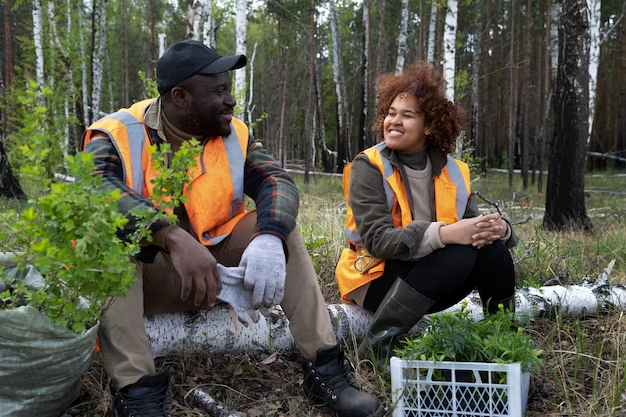The Power of Plants: How Reforestation Can Combat Climate Change
As the world grapples with the severe impacts of climate change, one of the most promising solutions lies in the power of plants—specifically, the act of reforestation. Forests cover about 31% of the Earth’s land area and are vital for sustaining life on our planet. They play an essential role in absorbing carbon dioxide (CO2), releasing oxygen, and providing habitat for a multitude of species.
However, deforestation has drastically reduced forested areas, contributing to increased greenhouse gas emissions and climate change. Reforestation, the process of replanting trees in deforested areas, offers a beacon of hope in the fight against climate change.
Understanding Reforestation
Reforestation is not merely about planting trees; it encompasses a range of practices aimed at restoring forests that have been degraded or destroyed. This can involve planting native tree species, managing existing forests sustainably, and rehabilitating land that has been subjected to deforestation. The goal is to create a healthy ecosystem that benefits both the environment and local communities.
The Role of Trees in Carbon Sequestration
One of the most significant contributions of trees to combating climate change is their ability to sequester carbon. Through photosynthesis, trees absorb CO2 from the atmosphere and store it in their biomass—trunks, branches, leaves, and roots. This process effectively removes carbon from the atmosphere, mitigating the greenhouse effect.
According to research from the Intergovernmental Panel on Climate Change (IPCC), restoring forests could sequester up to 1.1 gigatons of CO2 each year. This is equivalent to taking approximately 240 million cars off the road annually.
Enhancing Biodiversity
Reforestation also plays a critical role in enhancing biodiversity. Forests are home to around 80% of terrestrial species, providing essential habitats for countless plants, animals, and microorganisms.
By restoring forest ecosystems, we can help revive endangered species and promote a rich tapestry of life. This biodiversity is crucial not only for ecological balance but also for human survival, as it supports food systems, medicine, and clean water.
Protecting Watersheds
Forests are integral to maintaining healthy watersheds. They regulate water cycles, preventing soil erosion, and ensuring a clean water supply.
By absorbing rainfall and slowly releasing it into rivers and streams, trees help to maintain water quality and reduce the risk of floods. Reforestation projects can restore these natural water systems, ultimately benefiting both the environment and communities that rely on these resources.
Socioeconomic Benefits
Reforestation is not only an environmental imperative; it also brings significant socioeconomic benefits. Healthy forests provide resources such as timber, fruits, nuts, and other non-timber forest products, which can support local economies.
Additionally, reforestation projects often create jobs in tree planting, maintenance, and sustainable forest management. These opportunities can lift communities out of poverty while fostering a sense of stewardship over their natural resources.
Global Reforestation Initiatives
Various global initiatives are focused on promoting reforestation. The Bonn Challenge, for example, aims to restore 150 million hectares of deforested and degraded land by 2020, with a target of 350 million hectares by 2030.
Similarly, the Trillion Trees initiative, led by the World Wildlife Fund, seeks to plant and protect one trillion trees worldwide. These initiatives highlight the growing recognition of reforestation as a viable strategy for climate change mitigation.
The Importance of Community Involvement
Successful reforestation projects depend on community involvement. Engaging local populations ensures that reforestation efforts are culturally appropriate and tailored to the specific needs of the area.
Indigenous communities, in particular, have invaluable knowledge about local ecosystems and can play a pivotal role in restoring forests. Moreover, involving communities fosters a sense of ownership and responsibility, increasing the likelihood that reforested areas will be protected long-term.
Challenges to Reforestation
Despite its benefits, reforestation faces several challenges. One major hurdle is land-use competition; agricultural expansion, urbanization, and infrastructure development often take precedence over reforestation efforts.
Additionally, funding and resources can be limited, particularly in developing regions. Climate change itself can also impact the success of reforestation initiatives, as changing weather patterns may alter the suitability of certain tree species in specific areas.
In Conclusion
Reforestation offers a robust and natural approach to addressing climate change. By capturing carbon dioxide, boosting biodiversity, safeguarding watersheds, and delivering socioeconomic benefits, the process of planting trees can significantly impact our planet. For reforestation initiatives to thrive, however, they require backing from government entities, NGOs, and local communities.
As we advance in the battle against climate change, harnessing the potential of plants through reforestation is essential for fostering a sustainable and resilient future for everyone. In Boise, professional land surveyors play a critical role in identifying suitable areas for tree planting, ensuring that these initiatives are implemented effectively. Whether it’s through supporting local tree-planting projects, championing sustainable land-use policies, or engaging in reforestation activities, each contribution is vital in our collective endeavor to restore the Earth.
Keep an eye for more news & updates on NyHeading!






